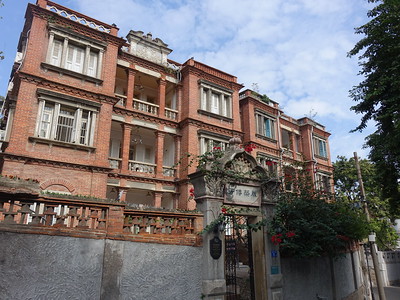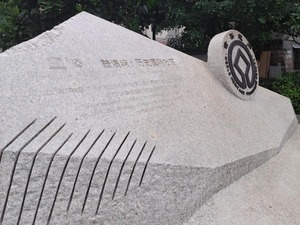Kulangsu

Kulangsu: A Historic International Settlement covers an island where Chinese, Southeast Asian and European architectural and cultural values came together.
Foreign missionaries, diplomats and workers lived on Kulangsu while working in the larger city of Xiamen across the strait. They were instrumental in introducing modern Western culture and technology to China in the late 19th and early 20th centuries. The fusion of cultures also resulted in a new architectural style: Amoy Deco.
Community Perspective: Els has written a comprehensive overview of a 3-hour visit to the island, where the exteriors of the historic buildings stand out.



Map of Kulangsu
Community Reviews
Bernard Joseph Esposo Guerrero

Going to Gulangyu is very straight-forward: a bus to the International Ferry Terminal, then a smooth 20-minute boat ride to the island. If one decides to leave the island after 6PM as my friend and I did, the ferries for tourists then operate at the Piano Ferry Terminal, making the return trip shorter (it also makes it easier to go to Zhongzhan Road next, another top tourist attraction of Xiamen). Before going to Gulangyu, I made a mental note on the buildings that Els failed to see as I curiously wanted to check them out. Upon exiting Sanqiutian Ferry Terminal, the imposing neo-Classical former building of the American Consulate (1930) greets you. Beside it is the former building of the Hongning Hospital, a brick corner building in the style of late Amoy Deco. As it is dubbed as the "Most Beautiful Corner of Gulangyu," a lot of locals are familiar with this building and they make their way up to this point to take their photos. Afterwards, they proceed to the more popular spots on the island namely the Organ Museum/Bagua Mansion (1908), the Piano Museum, and Sunset Rock.
As we were held hostage by the rain early on that day, we sought shelter at Rivers Cafe, which is housed in one of the marked villas. The hour or so spent there was not wasted as we took that opportunity to explore what one of the old villas, which are often fenced and closed, looks like on the inside. Moving away from the tourist trail, we went to the section where the verandah-style former Residence of the Amoy Harbor Master is located. Also in that quiet area is the Amoy Customs Telecommunications Tower, a quaint Taoist shrine beside one of the blockhouses (part of a network of defensive structures), the former Hope Hospital/Kulangsu Gallery of Foreign Artifacts (1898) and Meiyuan Garden. No one goes to this side! We aimlessly wandered around waiting to be surprised by what were to be encountered, and I soon realized that what makes Gulangyu a joy to walk around in is that all historic buildings have markers and that there is no shortage of information boards to read.
We then reached Neicuo'ao District which happens to be the oldest settlement on the island. It was first occupied by the Li clan, and during the Qing dynasty, the Fujian Customs set there a customs clearance port which jumpstarted the development of the district. Neicuo'ao pivots on Zhongde Taoist Temple (originally built in the 1600s), and although not a highly commercialized section of Gulangyu there are several Hokkien-style and colonial buildings there that are still inhabited by the local residents. The district is a pleasant surprise since you hardly hear about it. Crossing Bishan Cave, which we later learned that "cave" is their term for the tunnels that cut through the central hills, leads to the Neo-Classical Trinity Church (1934), co-designed by Lin Rongting and a Dutch architect. At that point, we were already at the center of the island and on the Sunset Rock Loop.
Sunset Rock appears to be the favorite of most visitors as it offers an unobstructed panoramic view of the island and the mainland. If you want to skip paying the 60RMB entrance fee, upon entering the compound, turn left towards the (smaller) monument of Koxinga, the cherished Chinese hero. Behind it, built directly on the northeastern slope of the hill, is the Amoy Deco Xilin Villa (1910) that has links to the Philippines. It houses the free-entry Koxinga Memorial Museum (Some online posts, however, say that there is a small entrance fee. Try your luck!). The items on display have no translations in English and photography inside is not allowed. Still, the view from the third floor balcony makes the visit worth it, and the lack of hoards of tourists pushing and rushing you to move guarantees a more pleasant viewing experience than at Sunset Rock.
Moving down the slope of the hill to the south coast beach, one passes by a beautiful Amoy Deco gate of a beachside villa. Nearby is the still-functioning Koxinga's well and another blockhouse. Shuzhuang Garden (1913) of a Taiwanese businessman is perhaps one of the few coastal Chinese gardens, making it special. It also features a "10 scenic spots of the garden", a tradition that originated with Qing emperors. Its rock garden, described as a "Baroque rockery mountain," was designed by a German artist. Above it is the Piano Museum, established to bolster the claim of Gulangyu as a "Piano Island" or "Music Island" -- in fact, the small island even has the full-scale Gulangyu Concert Hall. It was in Gulangyu were the first pianos in East Asia appeared, developing a unique culture of Chinese musicality on a Western instrument. I recommend to wait for the scheduled playing of the pianos -- we heard two performances on two old pianos. Not far from that scenic section is the main stone marker of Kulangsu UNESCO World Heritage Site. It is at that point where the more commercialized area of the island comes to view, as well as where the top-gun villas are concentrated.
There is a nice collection of colonial monuments around the Foreigner's Football Pitch (1870s), and they largely comprise the most visited/photographed buildings in Gulangyu. Navigating our way to the Piano Ferry Terminal, we passed by the Lee House on Hangzhou Road, which sports some of the most interesting expressions of Amoy Deco through its house gables and three gates. On the slopes of Bijia Hill, Villa Yu Tiong Cuan, a compound of four mansions (1910-1930s) built by Filipino-Chinese immigrants, blends various architectural styles. Beside it is the Amoy Deco Ru Nan Villa with two exquisite Amoy Deco gates, and another fine balconied Amoy Deco mansion that appears to have seen better days. Zhangzhou Road is also nice to explore, and it is where one can find the brick bookstore of the South Fukien Religious Tract Society. We walked towards the port via Longtou Road, where the Western-style former buildings of the Commercial Amoy Telephone Limited (now China Post) and China & South Sea Bank Limited, as well as the Art Deco-ish Chinese Intangible Cultural Heritage Building, are located. The last major building to be seen on the way out is the former building of the British Consulate (1844).
As an Art Deco fan, Gulangyu's Amoy Deco lives up to expectations. This fusion architecture developed on the island and it later gained popularity in other parts of Fujian. Also, as a Filipino, it is easy to notice Gulangyu's links to the Philippines, a cultural tie that is mentioned several times. Overall, it is a pleasant World Heritage Site to visit and it kept me entertained the whole day. But, it really requires far more walking than one would expect.
Photo (clockwise): View of Kulangsu from the balcony of Xilin Villa/Koxinga Memorial Museum; former Hongning Hospital Building; Amoy Deco Lee Mansion and one of its gates.
Els Slots

Kulangsu: a historic international settlement comprises of an island off the coast of Xiamen that was inhabited by foreign traders, missionaries and diplomats in the 19th and early 20th centuries. Later in the 20th century, it also became home to Chinese who returned from abroad. Together they gave a modern impulse to China through the input of Western culture and technology. The circa 1000 preserved historic buildings show a mix of European, Chinese and South Asian architectural styles.
The island lies really just right off the coast, you can almost swim towards it. The ferry for the local residents also takes only 5 minutes. Tourists have to leave from a location further away though, with a boat that takes longer (20 minutes). There were at least 200 people on 'my' boat, all Chinese. Kulangsu (Gulangyu in modern Chinese) is a very popular destination for Chinese tour groups: there are no less than 13 million(!!) visitors per year. And that while there even is a daily limit on the number of visitors. On the weekends and around Chinese holidays you have to book the boat in advance, otherwise, you run the chance that the tickets for the day in question (with a maximum of 50,000!) have run out.
After arriving at the dock at 8.30 am on a weekday, I could leave with the 9.10 am ferry. The first boat of the day is at 7.10 am, so there were not many others on the island yet. It is also pretty big and there are no cars allowed, so you can leisurely walk around. I was blessed with a sunny day with temperatures above 20 degrees, so just walking around was a pleasure.
You do not have to look hard for historic buildings: there are a lot of them. What I found striking is that they are hidden behind high fences and walls. Many entrance doors I found also closed - people still live in most buildings. If you already manage to enter one, you will soon find yourself on the grounds of a café. There are a lot of signposts on the island but still I did not manage to find all buildings described as especially interesting in the nomination, such as the Hongning Hospital, the Yanping Complex, the former water supply facility, the building of the former Kulangsu Telephone Company, and the former building of China & South Sea Bank Limited.
The unique architectural style that has developed here on the island is called 'Amoy Deco': Amoy for the local name for Xiamen, and Deco to the art movement Art Deco. It produces houses in brick with Chinese-style ornaments. The island also has 3 Christian churches. These served today as a background for the wedding photos of newly married (or to-be-married) Chinese couples.
The island is a nice and relaxing place to walk around in good weather. The buildings, however, are not that interesting to a European person and I found it disappointing that you can not enter anywhere. To me, a visit of three hours was enough. A special mention has to be made about the street food: like in Xiamen on the mainland, the food stalls are a real asset of Gulangyu. You can serve me an oyster omelet any day!
Read more from Els Slots here.
Khuft

I visited Gulangyu (Kulangsu) in 2010, during a weekend trip to Xiamen (and the Fujian tulou), flying in from Hong Kong, where I was staying for a few months. In a sense, Gulangyu delivers what Hong Kong or Shanghai only promise: the fusion of West and East in a late 19th century / early 20th century international settlement established to trade with China. Gulangyu is surprisingly big and quite well-preserved (though when I visited in 2010, a few of the mansions were in the process of being "spruced up"). Its architecture has a distinctive Western flair to it, but Chinese elements also appear here and there (and it includes at least one fully-fledged Chinese garden). A few parts, such as the giant statue of Koxinga, are of a younger age, and it's a bit strange that they have been inscribed too. As should be expected of most tourist sites in China (in particular those in the middle of a city), it is quite touristy, but (at least in 2010) still bearable. The lack of traffic is definitely a plus - one can just stroll aimlessly around the island to discover its various corners. Overall, it was a very pleasant visit, and a break from the general hubbub of modern Chinese city life.
Tony Crouch
I visited the island in August 2016. It is a delightful oasis of calm, with no cars permitted. The early C20th colonial architecture is abundant and spread across the island, which is fun to explore. There were few western visitors like myself, but it is a very popular domestic tourism site and ferry numbers are limited. I wish the authorities well in the 2017 World Heritage inscription and hope the impact of tourism will be controlled.
wang zhong
Visited Kulangsu in 2009. This island not far away from modern China City Xiamen (Amoy). The island is full of tourists by the time I visited and I believe the island itself became more and more heated over the years.
Away from the crowds you may find some peaceful beaches, architectures with obvious western influence. In general this is a popular place in China local love to travel.
Read more from wang zhong here.
Community Rating
- : Yinming Zhang Cutecid Bin Vernon Prieto
- : Allnamesused Alejandro Lau Rogerding
- : Gcjdavid ReallyDeepThoughts Khuft Xiquinho Silva Zhenjun Liu
- : Chenboada Alex Marcean Ssong.x Kbtwhs Kevin McFarland Pchxiao
- : Michael anak Kenyalang Els Slots Hanming Christravelblog George Evangelou Eric PK Jeffrey Chai Ran Lichia Naim Y Ludvan Luke LOU Everett Bernard Joseph Esposo Guerrero
- : Alexander Lehmann Zoë Sheng YAO WEI Mo-han Je Dwight Zehuan Xiao
- : Stanislaw Warwas Dorejd Trekkie900 Kasper
- : DL Shijie ZHU
Site Info
Site History
2017 Inscribed
Site Links
Connections
The site has 16 connections
Art and Architecture
Constructions
Geography
History
Human Activity
Timeline
Trivia
Visiting conditions
WHS Hotspots
WHS Names
World Heritage Process
Visitors
128 Community Members have visited.

